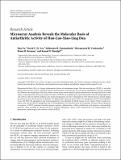| dc.contributor.author | Yu, Hua | en_US |
| dc.contributor.author | Lee, David Y.-W. | en_US |
| dc.contributor.author | Nanjundaiah, Siddaraju M. | en_US |
| dc.contributor.author | Venkatesha, Shivaprasad H. | en_US |
| dc.contributor.author | Berman, Brian M. | en_US |
| dc.contributor.author | Moudgil, Kamal D. | en_US |
| dc.date.accessioned | 2014-03-01T02:25:01Z | |
| dc.date.issued | 2013 | en_US |
| dc.identifier.citation | Yu, Hua, David Y.-W. Lee, Siddaraju M. Nanjundaiah, Shivaprasad H. Venkatesha, Brian M. Berman, and Kamal D. Moudgil. 2013. “Microarray Analysis Reveals the Molecular Basis of Antiarthritic Activity of Huo-Luo-Xiao-Ling Dan.” Evidence-based Complementary and Alternative Medicine : eCAM 2013 (1): 524746. doi:10.1155/2013/524746. http://dx.doi.org/10.1155/2013/524746. | en |
| dc.identifier.issn | 1741-427X | en |
| dc.identifier.uri | http://nrs.harvard.edu/urn-3:HUL.InstRepos:11855843 | |
| dc.description.abstract | Rheumatoid arthritis (RA) is a chronic inflammatory disease of autoimmune origin. Huo-luo-xiao-ling dan (HLXL) is an herbal mixture that has been used in traditional Chinese medicine over several decades to treat chronic inflammatory diseases including RA. However, the mechanism of the anti-arthritic action of this herbal remedy is poorly understood at the molecular level. In this study, we determined by microarray analysis the effects of HLXL on the global gene expression profile of the draining lymph node cells (LNC) in the rat adjuvant arthritis (AA) model of human RA. In LNC restimulated in vitro with the disease-related antigen mycobacterial heat-shock protein 65 (Bhsp65), 84 differentially expressed genes (DEG) (64 upregulated and 20 downregulated) versus 120 DEG (94 upregulated and 26 downregulated) were identified in HLXL-treated versus vehicle (Water)-treated rats, respectively, and 62 DEG (45 upregulated and 17 downregulated) were shared between the two groups. The most affected pathways in response to HLXL treatment included immune response, inflammation, cellular proliferation and apoptosis, and metabolic processes, many of which are directly relevant to arthritis pathogenesis. These results would advance our understanding of the mechanisms underlying the anti-arthritic activity of HLXL. | en |
| dc.language.iso | en_US | en |
| dc.publisher | Hindawi Publishing Corporation | en |
| dc.relation.isversionof | doi:10.1155/2013/524746 | en |
| dc.relation.hasversion | http://www.ncbi.nlm.nih.gov/pmc/articles/PMC3745855/pdf/ | en |
| dash.license | LAA | en_US |
| dc.title | Microarray Analysis Reveals the Molecular Basis of Antiarthritic Activity of Huo-Luo-Xiao-Ling Dan | en |
| dc.type | Journal Article | en_US |
| dc.description.version | Version of Record | en |
| dc.relation.journal | Evidence-based Complementary and Alternative Medicine : eCAM | en |
| dc.date.available | 2014-03-01T02:25:01Z | |
| dc.identifier.doi | 10.1155/2013/524746 | * |


